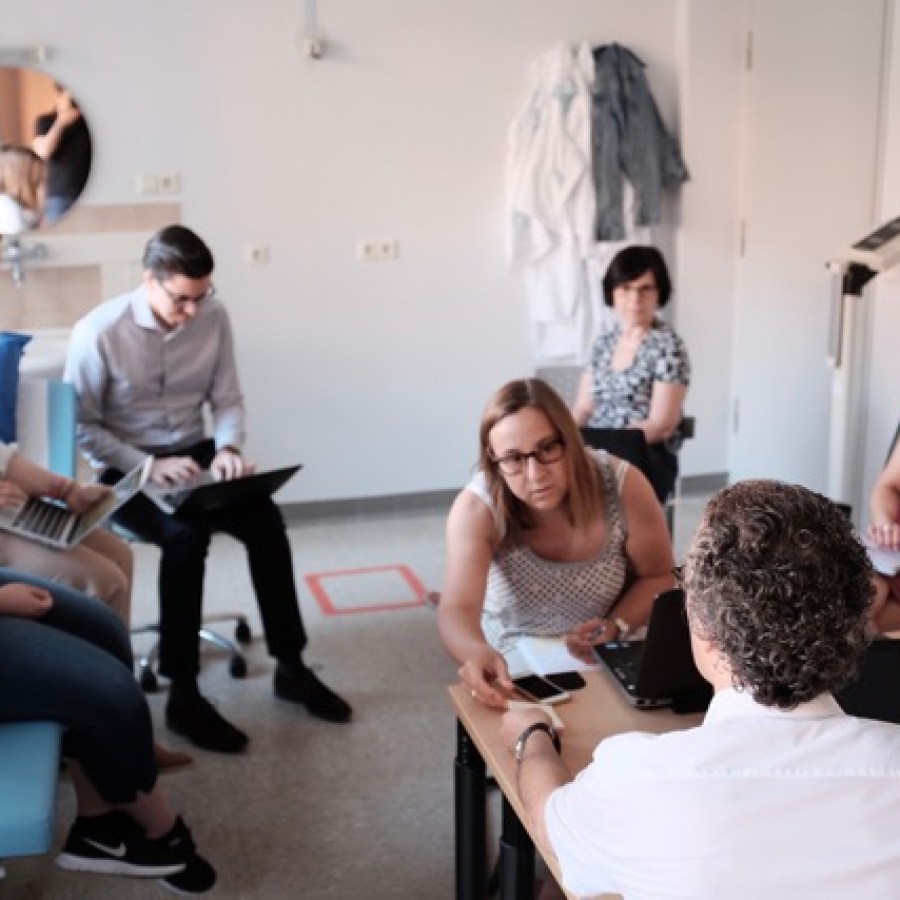10 selected Research Luxembourg results – April 2025
14 May 2025

Luxembourg News in Science & Research
Coloured solar cells for a better acceptance; Sensors providing data on the health of concrete; News on the functioning of the placebo effect; A black coating that absorbs light; Mini brains to better understand Parkinson’s; Sleep deprivation for children with type 1 diabetes: here are the latest scientific news from Luxembourg.
LIST; Pixabay; Flickr; Pexels
This article was originally in French and German on science.lu
LetzColor: Coloured solar cells to make them more widely accepted
Faculty of Science, Technology and Medicine (FSTM), University of Luxembourg
Have you ever dreamed of changing the color of your solar panels? LetzColor, a project from the University of Luxembourg, makes it possible—without significant energy loss.
LetzColor’s mission is to integrate solar technology into modern life. By coloring solar cells, they become more visually appealing. The goal is to increase public acceptance. Specifically, cholesteric liquid crystals are used on the solar cells to reflect color while transmitting light. Energy production is reduced by only 6 to 7%, compared to up to 50% with other methods. The liquid crystals also adapt to the background, making it harder to tell from a distance that it’s a solar cell.
The ultimate goal is to use these enhanced photovoltaic panels as building elements. They will serve both for insulation and electricity generation, in line with EU regulations.
Advanced sensors provide real-time data on the condition of infrastructure
Faculty of Science, Technology and Medicine (FSTM), University of Luxembourg
What if concrete could talk to us? Professor Numa Bertola and his team at the University of Luxembourg are using advanced sensor technology to deliver precise information on the condition of concrete structures.
How? Fiber optic sensors are deployed on bridges and other structures, allowing data to be collected every two millimeters. This information is transmitted in real time. Typically, only 1 to 5 measurement points are used on a 35-meter bridge; with this new technology, that number increases to 11,000 points.
One of the main practical applications of this research is to improve bridge safety by detecting potential damage before it leads to catastrophic failure. With a focus on sustainability, the research emphasizes assessing existing structures rather than designing new ones.
The placebo effect works better in people with intact brain function
Faculty of Humanities, Education and Social Sciences, University of Luxembourg
Older adults with good cognitive function respond better to placebo treatments. This is the result of a recent study by the University of Luxembourg and the University of the Balearic Islands.
The study explores how aging and changes in brain function affect the ability to experience relief from a placebo treatment. Until now, research had not provided clear results on this topic. The findings: older individuals with better executive functions (working memory, cognitive flexibility) had stronger placebo responses than their peers, and in some cases, responses equal to those of young adults.
In summary, when executive functions are intact, it is possible to experience normal pain relief from a placebo even at an advanced age. This finding is significant because placebo effects play a major role in treatment outcomes. The cognitive state of patients deserves to be considered when choosing a therapy.
“Miniature brains” help better understand Parkinson’s disease
Luxembourg Centre for Systems Biomedicine (LCSB), University of Luxembourg
How does Parkinson’s disease spread in the brain? Researchers from the LCSB and their international collaborators have observed the spread of alpha-synuclein aggregates—a protein involved in the disease—within “miniature brains” grown from patient cells. This study provides new insights into how Parkinson’s disease progresses.
In a healthy brain, alpha-synuclein plays a role in communication between neurons. In Parkinson’s disease, the protein misfolds and aggregates, damaging nerve cells. This is a hallmark of the disease. To study these aggregates, the researchers developed “miniature brains”—three-dimensional structures created in the lab from human stem cells.
Understanding how these alpha-synuclein aggregates spread can lead to the development of new therapeutic strategies.
To the press release | To the publication
A coating so black it absorbs 99.4% of light
Luxembourg Institute of Science and Technology (LIST)
Black absorbs light—but how much exactly? The LIST has developed a coating so black it absorbs 99.4% of light: a super-black. This coating uses carbon nanostructures to trap light, effectively eliminating stray reflections that can interfere with the performance of optical systems.
According to the researchers, this coating could make devices more precise, more reliable, and better suited for extreme environments. Its potential applications are numerous: aerospace optics and space telescopes, advanced imaging systems, and high-precision scientific instruments. It can be applied to silicon microchips, quartz, copper, aluminum, and more.
The project, called STRAYPROTECT, was launched in response to a request from the European Space Agency (ESA) and the Luxembourg Space Agency (LSA).
To the press release | To the publication

Lack of sleep: a problem for children with type 1 diabetes
Centre Hospitalier de Luxembourg (CHL) / Luxembourg Institute of Health (LIH)
Children with type 1 diabetes, as well as their parents, experience fragmented sleep despite the use of advanced monitoring technologies. This is one of the findings from a recent study conducted by researchers at CHL and LIH.
The aim of the study was to compare two different treatments using the same insulin pump and assess their impact on sleep. All study participants were found to be sleep-deprived (children more so than their parents). No significant differences were observed between the systems.
The fear of hypoglycemia can lead to chronic sleep disturbances for both parents and their diabetic children. New technologies have been introduced to support care, but alerts can be perceived as intrusive and stressful, often leading to night time awakenings. Future research will need to take into account the psychosocial impacts of diabetes and related technologies.
To the press release | To the publication
Luxembourg could suffer from U.S. economic policy
Despite low direct exposure, Luxembourg could be negatively affected by the indirect consequences of the new U.S. trade policy. These effects are due to a decrease in U.S. demand toward its European partners (such as Germany), and more broadly, to a deterioration of the global economic outlook.
In a recent publication, STATEC outlines the impact of current U.S. policies on the Grand Duchy’s economy. According to the authors, in terms of goods trade, the United States has accounted for only about 3% of Luxembourg’s exports in recent years. This share is higher (6 to 7%) for metals and industrial products. For services trade, the U.S. represents around 4 to 5% of Luxembourg’s total exports.
However, U.S. tariffs directly target German car exports, and Germany is Luxembourg’s main trading partner. There are also concerns about contagion effects through financial markets.
Older adults overlooked in European cancer care guidelines
Luxembourg Institute of Health (LIH)
Critical gaps exist concerning older adults in national and international cancer care guidelines—this is the finding of a recent study led by Dr. India Pinker from the LIH.
Although cancer prevalence among older people is steadily increasing, specific recommendations for this group remain insufficient and inconsistent, with significant regional disparities (Western European countries have more coherent guidelines than Eastern European ones). Newer, less toxic treatments—crucial for older adults—are often less accessible in lower-income countries such as Portugal or Romania. For this study, researchers analysed 187 documents from 31 European countries, focusing on five types of cancer: breast, prostate, colorectal, lung, and bladder.
In Luxembourg, at the time of analysis, only two national guidelines were in place, and only those related to colorectal cancer included recommendations for older adults. Developing expertise in geriatric oncology is essential to improving the quality of care.
To the press release | To the publication
New Report on Trauma Highlights the Importance of Prevention
Luxembourg Institute of Health (LIH)
How can we prevent injuries and deaths from accidents? By improving prevention. That’s the conclusion of a new report from the LIH, which sheds light on injury trends in Luxembourg and outlines the prevention strategies needed to avoid them.
The “Report on Trauma and Accident Trends in Luxembourg” provides an in-depth analysis of trauma cases and accidental deaths recorded in emergency departments between 2013 and 2020. The groups most affected by trauma are children, adolescents, young adults, and the elderly (who are 1.4 to 1.8 times more at risk than adults aged 25 to 69). And the impact of the pandemic? In 2020, there was a significant drop in emergency room visits for trauma across all age groups—except seniors. In contrast, traumatic incidents among seniors increased by 4.4%.
The goal of the study is to improve prevention strategies and strengthen public safety measures.
To the press release | To the publication (in French)
Great Diversity and High Salaries in Luxembourg’s Job Market
On the occasion of Labor Day, STATEC highlights key data on employment in Luxembourg.
According to the report, in 2024, the Grand Duchy had 489,000 employees, nearly half of whom (47%) were cross-border workers, mainly from France (126,000). Only 1 in 4 employees is of Luxembourgish nationality.
Luxembourg also stands out for its high wages, ranking second in the European Union with a median hourly wage of €24. Remarkably, the gender pay gap is reversed in Luxembourg, with women earning on average more than men (a pay gap of -0.7%), making the country a unique case in Europe.
A large majority of residents (80%) report being in good health, a factor that directly influences their participation in the labour market.
Finally, the female employment rate has continued to rise, reaching 67.0% (up from 66.8% in 2023).
Author: Diane Bertel
Editor: Lucie Zeches (FNR) ; Hélène Jacuszin (Research Luxembourg)












